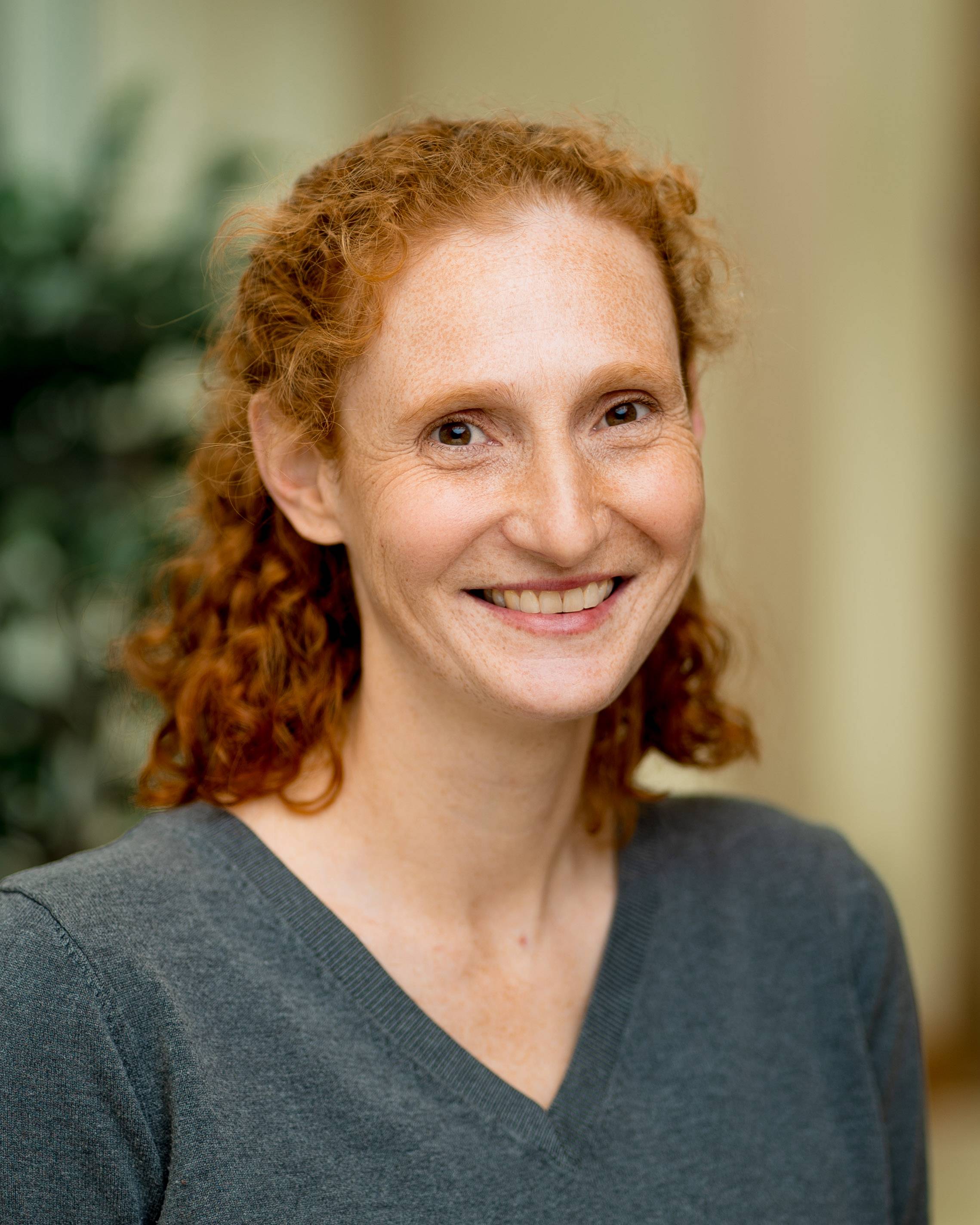
Anne Perring
Department/Office Information
Chemistry- M 9:30am - 11:00am (302A Wynn Hall)
- R 3:00pm - 4:30pm (302A Wynn Hall)
I grew up in California and received a BS in Chemistry from Brown University where I did research on both water quality and paleoclimate. I did my graduate work with Ron Cohen in the UC Berkeley College of Chemistry where I focused on photochemical ozone production and reactive nitrogen cycling. After receiving my PhD, I became a research scientist at the National Oceanic and Atmospheric Administration in Boulder, CO studying several kinds of atmospheric aerosol. I spent 9 years there doing a variety of airborne, ground-based and laboratory work on black carbon and biological aerosol before joining the Chemistry Department at Colgate.
In my current research, my students and I use a variety of tools to study primary biological aerosol (bacteria, fungal spores and pollen) which can impact cloud formation and the hydrological cycle as well as human, animal and plant health. We also have a continuing collaboration with NOAA to measure black carbon aerosol from airborne platforms to better understand its sources, chemical transformations and radiative impacts in the atmosphere.
If you would like to learn more, please see sections below on research and publications.
University of California, Berkeley, PhD in Chemistry (2009)
Brown University, ScB with Honors in Chemistry (2003)
Atmospheric Chemistry, Environmental Chemistry, Analytical Chemistry
1. Primary Biological Aerosol
To study primary biological aerosol (PBA), composed of bacteria, fungal spores and pollen, we use a number of tools. First, we have a Micro-Orifice Uniform Deposition Impactor (MOUDI) which collects size-resolved aerosol from 50 nm to 18 μm. We install the instrument in an outdoor location to collect atmospheric samples which we analyze for deposition-mode ice nuclei as well as biomarkers like amino acids and fungal alcohols. We also have a real-time single particle fluorescence instrument (the Instascope) which provides high time resolution data and helps us put our offline measurements into context. We are interested in seasonal cycles of biological aerosol, the behavior and composition of biological aerosol and ecosystem response to meteorological and climatic events.
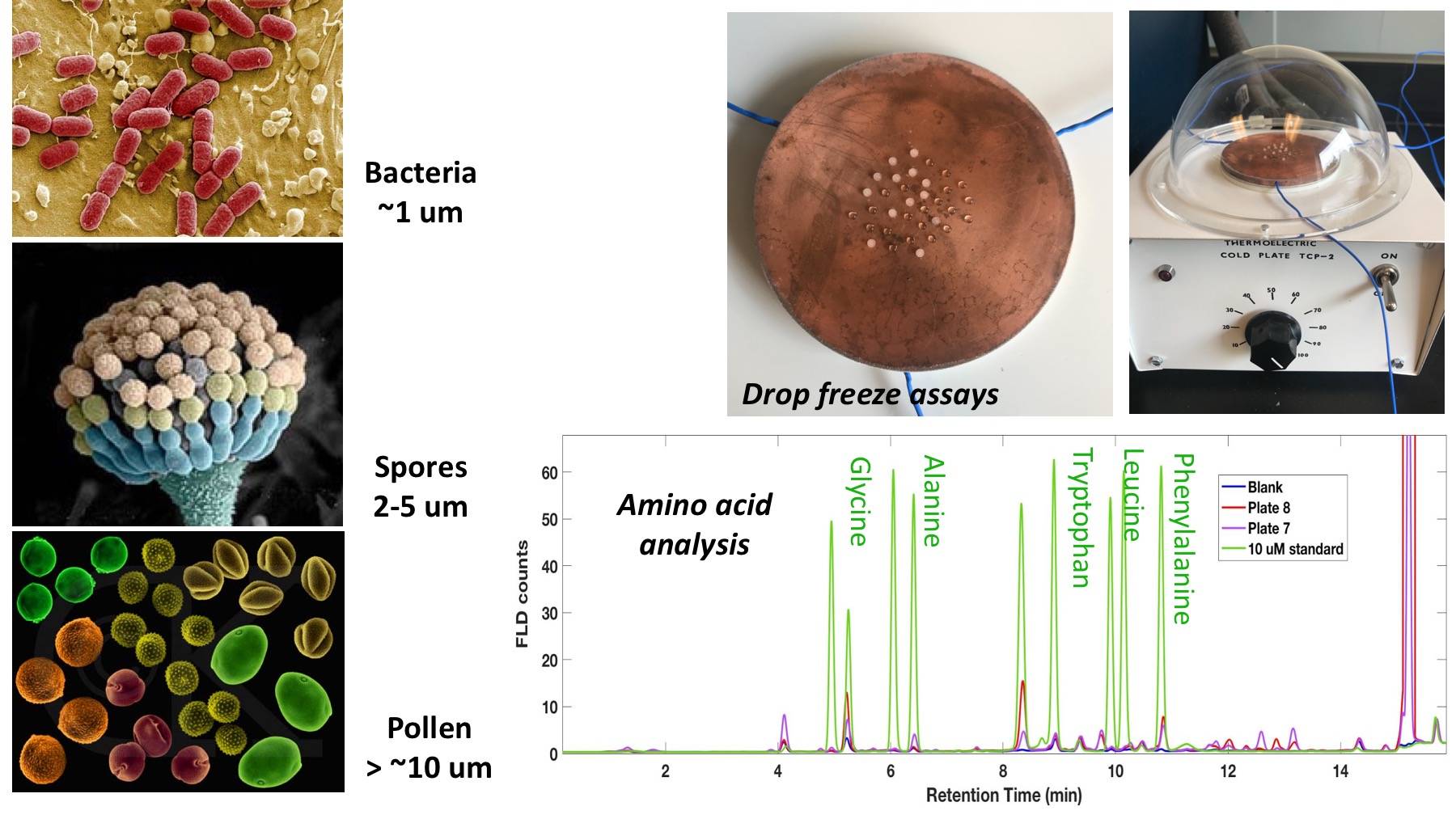
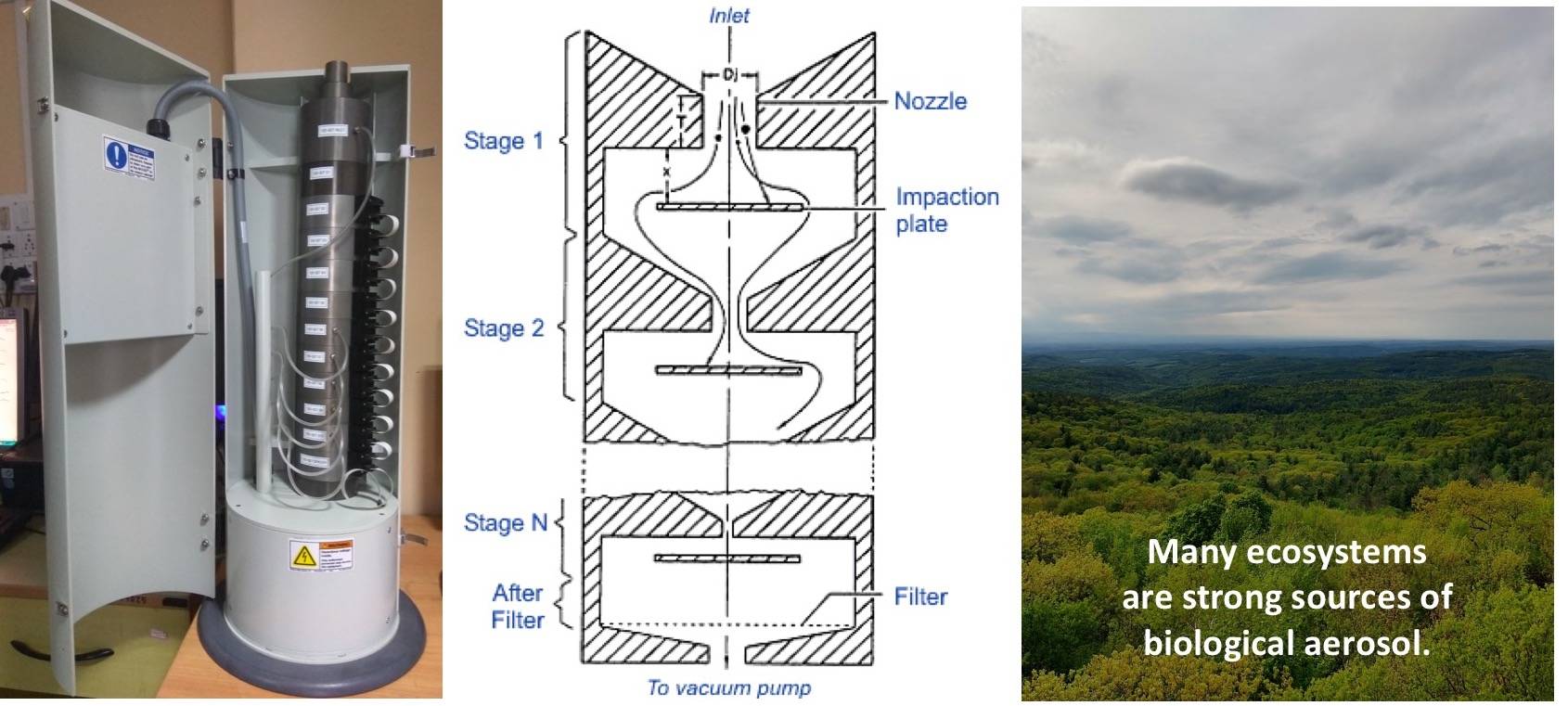
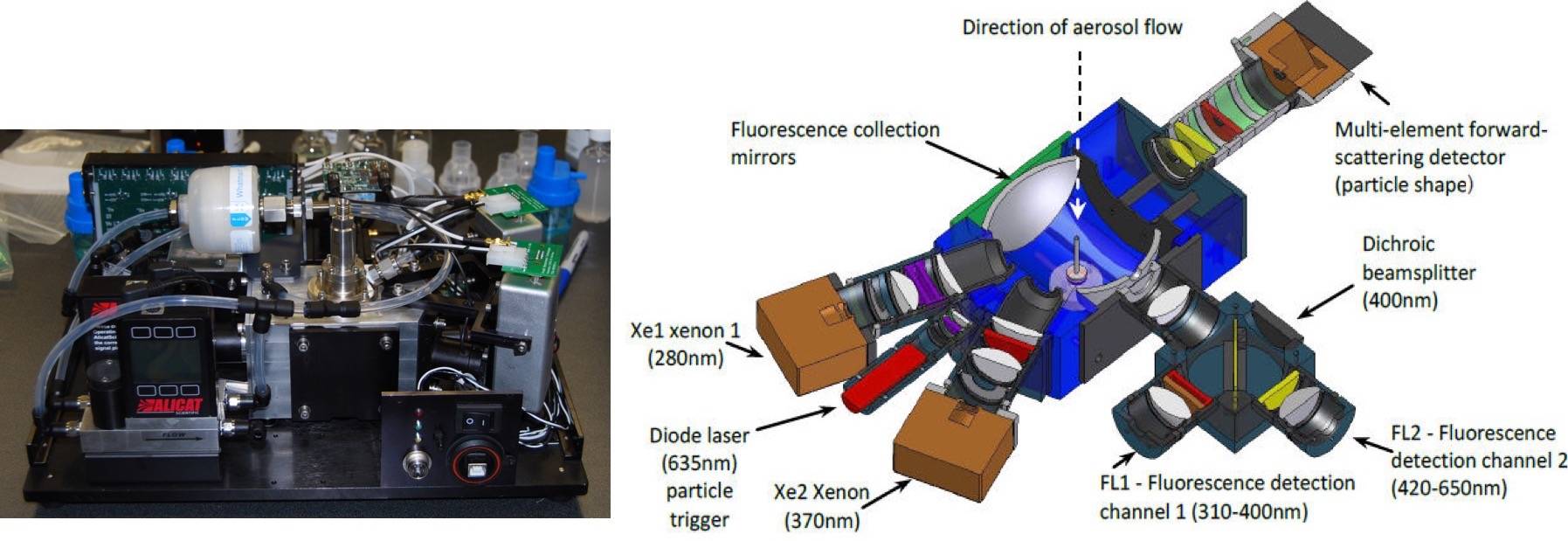
2. Black Carbon
Black carbon (colloquially referred to as "soot") is an absorbing aerosol species with impacts on climate and health. Our work with black carbon is an ongoing collaboration with colleagues at NOAA in Boulder who own and operate a Single Particle Soot Photometer (SP2) on various multi-agency airborne projects focused on air quality and climate. We have been involved in several recent missions. During the summer of 2019 we helped with the FIREX mission in Boise, Idaho which focused on emissions of particles and gasses from fires. During the summer of 2022 we helped with the ACCLIP mission, based out of Osan AFB in South Korea, which focused on transport of pollution from the surface through convective systems associated with the Asian Summer Monsoon. Most recently, during the summer of 2023, we participated in the AEROMMA mission focused on urban air quality in North American cities.
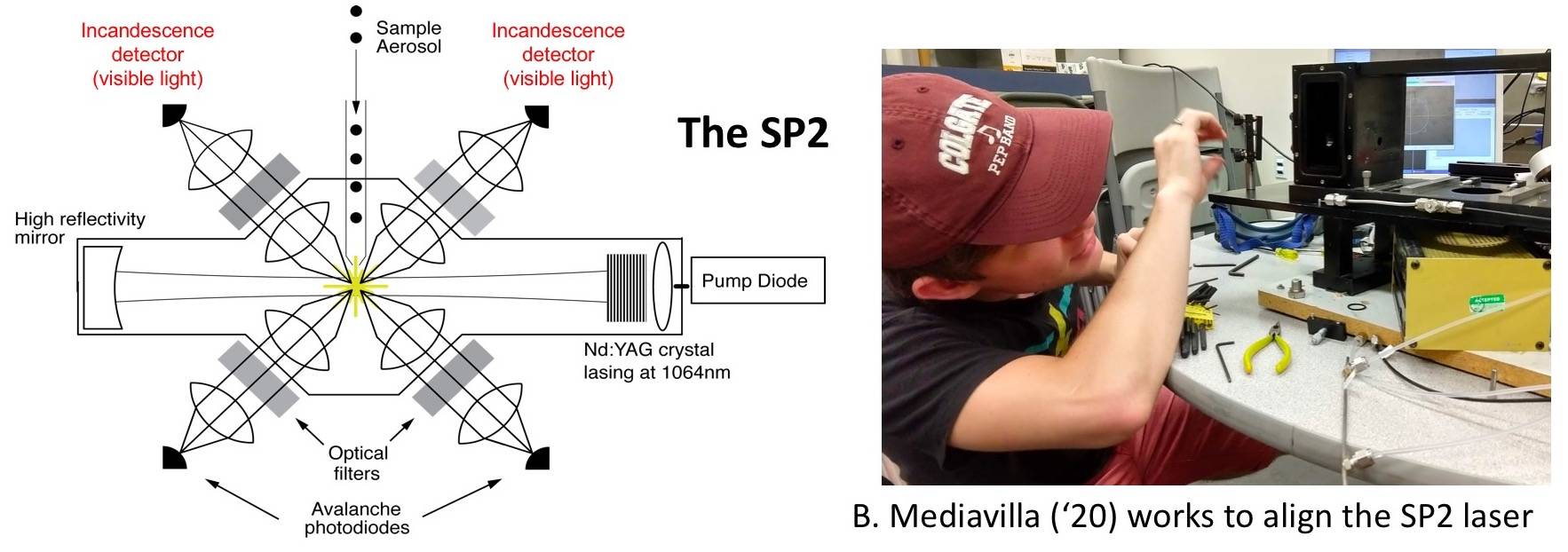
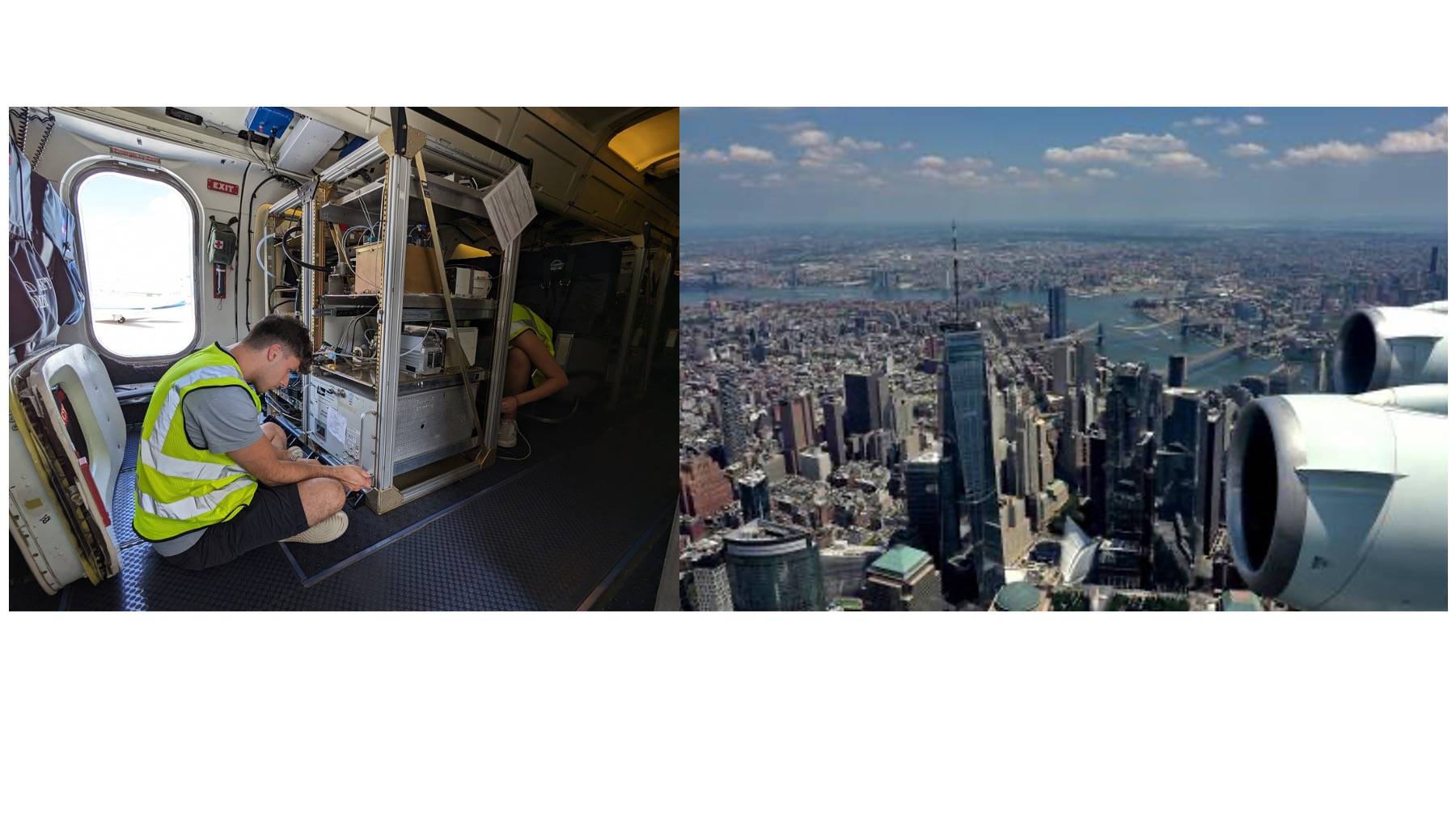
Professor Perring loves to work with Colgate's outstanding students. Interested Colgate students are encouraged to get in touch with Professor Perring about potential projects.
Current group:
Morgan Usselman ('24)
Joseph Berberich ('24)
Anna Hill ('24)
Ekaterina Balsan ('23)
Former members:
J.P. McMahon ('19)
Matt Carrandang ('19)
Molly Frauenheim ('20)
Konrad McKalip ('20)
Brady Mediavilla ('20)
Yejin Cha ('21)
G. Dewey Wilbanks ('21)
Dechok De ('22)
Sara Million-Perez ('22)
Steph Jacoby ('23)
Carla Perdomo ('23)
Abbie Grady ('23)
Gia D'Erasmo ('23)
(undergraduate co-authors marked with *)
85. Perring, A.E.; Mediavilla, B.*; Wilbanks, G.D.*; Churnside, J.H.; Marchbanks, R.; Lamb, K.D.; Gao, R.S. Airborne Bioaerosol Observations Imply a Strong Terrestrial Source in the Summertime Arctic. JGR-Atmospheres. doi/10.1029/2023JD039165, 2023.
84. Katich, J. M., et al., Pyrocumulonimbus Affect Average Stratospheric Aerosol Composition. Science, 379 (6634), 815–820. https://doi.org/10.1126/science.add3101, 2023.
83. Saide, P. E., et al., Understanding the Evolution of Smoke Mass Extinction Efficiency Using Field Campaign Measurements. Geophysical Research Letters https://doi.org/10.1029/2022GL099175, 2022.
82. Kumar, A., et al., Simulating wildfire emissions and plume rise using geostationary satellite fire radiative power measurements: a case study of the 2019 Williams Flats fire. Atmos. Chem. Phys., DOI: 10.5194/acp-22-10195-2022, 2022.
81. Stockwell, CE, et al., Airborne Emission Rate Measurements Validate Remote Sensing Observations and Emission Inventories of Western US Wildfires. Env. Sci. Tech., DOI: 10.1021/acs.est.1c07121, 2022.
80. Zeng, et al., Characteristics and evolution of brown carbon in western United States wildfires., Atmos. Chem. Phys., DOI: 10.5194/acp-22-8009-2022, 2022.
79. Adachi, et al.*, Fine Ash-Bearing Particles as a Major Aerosol Component in Biomass Burning Smoke, J. Geophys. Res.-Atmos., DOI: 10.1029/2021JD035657, 2021.
78. Wiggins, E. B., et al., Reconciling Assumptions in Bottom-Up and Top-Down Approaches for Estimating Aerosol Emission Rates From Wildland Fires Using Observations From FIREX-AQ. J. Geophys. Res.-Atmos., DOI: 10.1029/2021JD035692, 2021.
77. Choi, Y. et al., Temporal and spatial variations of aerosol optical properties over the Korean Peninsula during KORUS-AQ., Atmospheric Environment, 254, Article # 118301, DOI: 10.1016/j.atmosenv. 2021.118301, 2021.
76. Janssen, R.H., et al., Drivers of the fungal spore bioaerosol budget: observational analysis and global modeling. Atmospheric Chemistry and Physics, 21 (6), DOI: 10.5194/acp-21-4381-2021, 2021.
75. Lamb, K.D., et al., “Global-scale constraints on light-absorbing anthropogenic iron oxide aerosols”, NPJ Climate and Atmospheric Science, 4 (1), DOI: 10.1038/s41612-021-00171-0, 2021.
74. Wiggins, E., et al., High Temporal Resolution Satellite Observations of Fire Radiative Power Reveal Link Between Fire Behavior and Aerosol and Gas Emissions. Geophysical Research Letters, 47 (23), e2020GL090707. https:// doi.org/10.1029/2020GL090707, 2020.
73. Saide et al., Understanding and improving model representation of aerosol optical properties for a Chinese haze event measured during KORUS-AQ. Atmos. Chem. Phys., 20 (11), https://doi.org/10.5194/acp-20-6455-2020, 2020.
72. Huffman JA, Perring AE, et al., Real-time sensing of bioaerosols: Review and current perspectives, Aero. Sci. Tech., DOI 10.1080/02786826.2019.1664724, 2020.
71. Zawadowicz et al., Model-Measurement Consistency and Limits of Bioaerosol Abundance Over the Continental United States, Atmos Chem. Phys., 19 (22), 2019.
70. Duflot et al. Preliminary results from the FARCE 2015 campaign: multidisciplinary study of the forests–gases–aerosols–clouds system on the tropical island of La Réunion, Atmos. Chem. Phys., 19 (6), 2019.
69. Kaiser et al., Global aerosol modeling with MADE3 (v3.0) in EMAC (based on v2.53): model description and evaluation, Geosci. Mod. Dev., 12 (1) , 2019.
68. Ullrich R, et al., Comparison of Modeled and Measured Ice Nucleating Particle Composition in a Cirrus Cloud, J. Atmos. Sci., 76 (4), 2019.
67. Lamb K, Perring AE, et al., Estimating source region influences on black carbon abundance, microphysics and radiative effect observed over South Korea, J. Geophys. Res.–Atm., 123 (23), 2018.
66. Mason B., et al., An intercomparison of aerosol absorption measurements conducted during the SEAC4RS campaign, Atmos. Meas. Tech., 52 (9), 2018.
65. Markovic MZ, Perring AE, et al., Limited impact of sulfate-driven chemistry on black carbon aerosol aging in power plant plumes, AIMS Env. Sci., 5 (3), pp 195-215, 2018.
64. Wang X, et al., Exploring the observational constraints on the simulation of brown carbon, Atmos. Chem. Phys., 18 (2), 2018.
63. Katich JM, Perring AE and Schwarz JP, Optimized detection of particulates from liquid samples in the aerosol phase: Focus on black carbon, Atmospheric Measurements and Techniques, 51 (5), 2017.
62. Zhang Y., et al., Top-of-atmosphere radiative forcing affected by brown carbon in the upper troposphere, Nature Geosci., doi:10.1038/NGEO2960, 2017.
*61. Robinson ES, Schwarz JP, Gao RS, Fahey DW and Perring AE, Fluorescence calibration method for single-particle aerosol fluorescence instruments, Atmos. Meas. Tech., https://doi.org/10.5194/amt-10-1755-2017, 2017.
60. Schwarz JP, et al, Aircraft measurements of black carbon vertical profiles show upper tropospheric variability and stability, Geophys. Res. Lett., 44 (2), doi: 10.1002/2016GL071241, 2017.
59. Perring AE, et al., In situ measurements of water uptake by black carbon-containing aerosol in wildfire plumes, J. Geophys. Res. – Atmos., 121, doi:10.1002/2016JD025688, 2017.
58. Yu P, et al., Surface dimming by the 2013 Rim Fire simulated by a sectional aerosol model, J. Geophys Res. – Atmos., 121 (12), 7079-7087, 2016.
57. Liu X, et al., Agricultural fires in the southeastern US during SEAC4RS: Emissions of trace gases and particles and evolution of ozone, reactive nitrogen and organic aerosol, J. Geophys. Res. – Atmos., 121 (12), 7383-7414, 2016.
56. Shingler T, et al., Airborne characterization of subsaturated aerosol hygroscopicity and dry refractive index from the surface to 6.5km during the SEAC4RS campaign, J. Geophys. Res. – Atmos., 121 (8), 4188-4210, 2016.
55. Gao RS, et al., A light-weight, high-sensitivity particle spectrometer for PM2.5 aerosol measurements, Aerosol Sci. & Tech., 50 (1), 88-99, 2016.
54. Brock CA, et al., Aerosol optical properties in the southeastern United States in summer – Part I: Hygroscopic growth, Atmos. Chem. Phys., 16 (8), 4987-5007, 2016.
53. Hernandez MT, Perring AE, et al., Chamber catalogues of optical and fluorescent signatures distinguish bioaerosol classes, Atmos. Meas. Tech., 9 (7), 3283-3292, 2016.
52. Kim et al., Source, seasonality and trends of southeast US aerosol: an integrated analysis of surface, aircraft, and satellite observations with the GEOS-Chem chemical transport model, Atmos. Chem. Phys., 15 (18), 2015.
51. Liu J., et al., Brown carbon aerosol in the North American continental troposphere: sources, abundance, and radiative forcing, Atmos. Chem. Phys., 15 (14), 2015.
50. Forrister, H. et al., Evolution of brown carbon in wildfire plumes, Geophysical Research Letters, 42 (11), 4623-4630, 2015.
49. Saide PE, et al., Revealing important nocturnal and day-to-day variations in fire smoke emissions through a multiplatform inversion, Geophysical Research Letters, 42 (9), 3609-3618, 2015.
48. Wagner NL, et al., In situ vertical profiles of aerosol extinction, mass and composition over the southeast United States during SENEX and SEAC4RS: observations of a modest aerosol enhancement aloft, Atmos. Chem. Phys., 15 (14), 2015.
47. Schwarz JP, Perring AE, et al., Technique and theoretical approach for quantifying the hygroscopicity of black-carbon-containing aerosol using a single particle soot photometer, J. Aerosol Sci, 81, pp110-126, 2015.
46. Perring AE, et al., Airborne observations of regional variation in fluorescent aerosol across the United States, J. Geophys. Res.–Atm., 120 (3), 2015.
45. Wang QQ, et al., Global budget and radiative forcing of black carbon aerosol: Constraints from pole-to-pole (HIPPO) observations across the Pacific, J. Geophys. Res.–Atm., 119 (1), 2014.
44. Wang X, et al., Exploiting simultaneous observational constraints on mass and absorption to estimate the global direct radiative forcing of black carbon and brown carbon, Atmos. Chem. Phys., 14 (20), 2014.
43. Fast JD, et al., Modeling regional aerosol and aerosol precursor variability over California and its sensitivity to emissions and long-range transport during the 2010 CalNex and CARES campaigns, Atmos. Chem. Phys., 14 (18), 2014.
42. Schwarz JP, et al., Global-scale seasonally resolved black carbon vertical profiles over the Pacific, Geophys. Res. Lett., 40 (20), 2013.
41. Perring AE, et al, Evaluation of a flat plate inlet for airborne sampling of interstitial aerosol, Aerosol Sci. Tech., 47 (10), 1066-1072, 2013.
40. Perring AE, Pusede SE and Cohen RC, An observational perspective on the atmospheric impacts of alkyl and multifunctional nitrates on ozone and secondary organic aerosol, Chem. Rev., 113 (8), 5848-5870, 2013.
39. Kipling Z, et al., Constraints on aerosol processes in climate models from vertically-resolved aircraft observations of black carbon, Atmos. Chem. Phys., 13, 5969-5986, 2013.
38. Bertram T, Perring AE, et al., On the Export of Reactive Nitrogen from Asia: NOx partitioning and Effects on Ozone, Atmos. Chem. Phys., 13, 4617-4630, 2013.
37. Schwarz JP, et al., Black carbon aerosol size in snow, Nature Sci. Rep., 3, 1356, 2013.
36. Gao RS, Perring AE, et al., A High-Sensitivity Low-Cost Optical Particle Counter Design, Aerosol Sci. Tech., 47 (2), 137-145, 2013.
35. Peischl J, et al., Airborne observations of methan emissions from rice cultivation in the Sacramento Valley of California, J. Geophys. Res.–Atm., 117, D00V25, 2012.
34. Schwarz JP, et al., Assessing Single Particle Soot Photometer and Integrating Sphere/Integrating Sandwich Spectrophotometer measurement techniques for quantifying black carbon concentration in snow, Atmos. Meas. Tech., 5, 2581-2592, 2012.
33. Bahreini R, et al., Gasoline emissions dominate over diesel in formation of secondary organic aerosol mass, Geophys. Res. Lett., 39, L06805, 2012.
32. Langridge JM, et al., Evolution of aerosol properties impacting visibility and direct climate forcing in an ammonia-rich urban environment, J. Geophys. Res.–Atm., 117, (D00V11), 2012.
31. Neuman JA, et al., Ozone and alkyl nitrate formation from the Deepwater Horizon oil spill atmospheric emissions, J. Geophys. Res.–Atm., 117, (D09305), 2012.
30. Moore RH, et al., CCN Spectra, Hygroscopicity, and Droplet Activation Kinetics of Secondary Organic Aerosol Resulting from the 2010 Gulf Oil Spill, submitted to Env. Sci. Tech., 46 (6), 3093-3100, 2012.
29. Pollack IB, et al., Airborne and ground-based observations of a weekend effect in ozone, precursors, and oxidation products in the California South Coast Air Basin, J. Geophys. Res. – Atm., 117, (D00V05), 2012.
28. Middlebrook AM, et al., Air Quality Implications of the Deepwater Horizon Oil Spill, Proc. Nat. Acad. Sci., doi:10.1073/pnas.1110052108, 2011.
27. Fried A, et al., Detailed comparisons of airborne formaldehyde measurements with box models during the 2006 INTEX-B and MILAGRO campaigns: potential evidence for significant impacts of unmeasured and multi-generation volatile organic carbon compounds, Atmos. Chem. Phys., 11, 11867-11894, 2011.
26. Lack DA, et al., Impact of Fuel Quality Regulation and Speed Reductions on Shipping Emissions: Implications for Climate and Air Quality, Env. Sci. Tech., 45, (20), 9052-9060, 2011.
25. Perring AE, et al., Characteristics of black carbon aerosol from a surface oil burn during the Deepwater Horizon oil spill, Geophys. Res. Lett., 38, (L17809), 2011.
24. Ryerson TB, et al., Atmospheric emissions from the Deepwater Horizon spill constrain air-water partitioning, hydrocarbon fate, and leak rate, Geophys. Res. Lett., 38, (L07803), 2011.
23. de Gouw JA, et al., Organic Aerosol Fomation Downwind from the Deepwater Horizon Oil Spill, Science, 331 (6022), 1295-1299, 2011.
22. Russell AR, Perring AE, et al., A high spatial resolution retrieval of NO2 column densities from OMI: method and evaluation, Atmos. Chem. Phys., 11 (16), 8543-8554, 2011.
21. Browne EC, Perring AE, et al., Global and regional effects of the photochemistry of CH3O2NO2: evidence from ARCTAS, Atmos. Chem. Phys., 11 (9), 4209-4219, 2011.
20. Farmer DK, Perring AE, et al., Impact of organic nitrates on urban ozone production, Atmos. Chem. Phys., 11 (9), 4085-4094, 2011.
19. Alvarado MJ, et al., Nitrogen oxides and PAN in plumes from boreal fires during ARCTAS-B and their impact on ozone: an integrated analysis of aircraft and satellite observations, Atmos. Chem. and Phys., 10 (20), 9739-9760, 2010.
18. Perring AE, et al., The production and persistence of RONO2 in the Mexico City plume, Atmos. Chem. Phys., 10 (15), 7215-7229, 2010.
17. Wooldridge PJ, Perring AE, et al., Total Peroxy Nitrates (Sigma PNs) in the atmosphere: the Thermal Dissociation-Laser Induced Fluorescence (TD-LIF) technique and comparisons to speciated PAN measurements, Atmos. Meas. Tech., 3 (3), 593-607, 2010.
16. Buscsela EJ, et al., Lightning-generated NOx seen by the Ozone Monitoring Instrument during NASA’s Tropical Composition, Cloud and Climate Coupling Experiment (TC4), J. Geophys. Res.-Atm., 115 (D00J10), 2010.
15. Schwarz JP, et al., The Detection Efficiency of the Single Particle Soot Photometer, Aerosol Sci. Tech., 44 (8), 612-628, 2010.
14. Hains JC, et al., Testing and improving OMI DOMINO tropospheric NO2 using observations from the DANDELIONS and INTEX-B validation campaigns, J. Geophys. Res.-Atm., 115 (D05301), 2010.
13. MacNaughton CS, et al., Observations of heterogeneous reactions between Asian pollution and mineral dust over the Eastern North Pacific during INTEX-B, Atmos. Chem. Phys., 9 (21), 8283-8308, 2009.
12. Perring AE, et al., A product study of the Isoprene+NO3 reaction, Atmos. Chem. Phys., 9 (14), 4945-4956, 2009.
11. Perring AE, et al., Airborne observations of total RONO2: New constraints on the yield and lifetime of isoprene nitrates, Atmos. Chem. Phys., 9 (4), 1451-1463, 2009.
10. Cooper OR, et al., Summertime buildup and decay of lightning NOx and aged thunderstorm outflow above North America, J. Geophys. Res.-Atm., 114 (D1), 2009.
9. Boersma KF, et al., Validation of OMI tropospheric NO2 during INTEX-B and application to constrain NOx emissions over the eastern United States and Mexico, Atmos. Env., 42 (19): 4480-4497, 2008.
8. Bucsela EJ, Perring AE, et al., Comparison of Tropospheric NO2 from in situ aircraft observations with near-real-time standard product data from OMI, J. Geophys. Res.-Atm., 113 (D16), 2008.
7. Horowitz LW, et al., Observational constraints on the chemistry of isoprene nitrates over the eastern United States, J. Geophys. Res.-Atmos, 112 (D12), 2007.
6. Singh HB, et al., Reactive nitrogen distribution and partitioning in the North American troposphere and lowermost stratosphere, J. Geophys. Res.-Atm., 112 (D12), 2007.
5. Kim S, et al., Measurement of HO2NO2 in the free troposphere during the intercontinental chemical transport experiment - North America 2004, J. Geophys. Res.-Atm., 112 (D12), 2007.
4. Bertram TH, Perring AE, et al., Direct measurements of the convective recycling of the upper troposphere, Science, 315 (5813), 816-820, 2007.
3. Hudman RC, et al., Surface and lightning sources of nitrogen oxides over the United States: Magnitudes, chemical evolution, and outflow, J. Geophys. Res.-Atm., 112 (D12), 2007.
2. Cooper OR, et al., Large upper tropospheric ozone enhancements above midlatitude North America during summer: In situ evidence from the IONS and MOZAIC ozone measurement network, J. Geophys. Res.-Atm., 111 (D24), 2006.
1. Perring AE, et al., Solute Dynamics in Storm Flow of the Ipswich River Basin: effects of land use, Biol. Bull., 199, 219-221, 2000.
Courses Taught:
Instrumental Analysis (Chem 371)
Practical Quantitative Analysis Laboratory (Chem 381)
General Chemistry II (Chem 102) and laboratory (102L)
The Chemistry of Altered and Natural Environments (Chem 100)
Environmental Chemistry (Chem 477)
Molecules, Energy and the Environment (Core 102S)
Global Change and YOU (Core 199S)